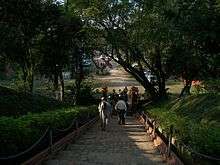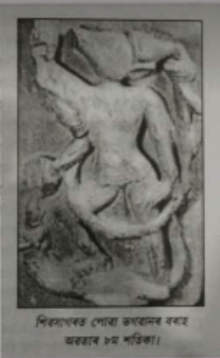Charaideo
Charaideo or Che-Rai-Doi (Literally: the shining city on the hills in Ahom language[1]) is a town in Charaideo district, Assam, India and was also the first capital of the Ahom kingdom established by the first Ahom king Chao Lung Siu-Ka-Pha in 1253.[2] Even though the capital moved to other places over the course of the 600 years of rule, Charaideo remained the symbol of Ahom power. It is now known for its collection of maidams, tumuli or burial mounds of the Ahom kings and Ahom royalty.

It is about 30 km from Sibsagar town located in Charaideo district
Etymology
Che-Rai-Doi (now: Charaideo) was established by the first Ahom king Chaolung Sukaphaa after about twenty years of looking for a suitable location and at Charaideo he erected a fort.[3][4][5][6][7]The name Charaideo originated from Tai-Ahom word Che Rai Doi or Doi Che Rai which means the shining city on the hillsThe Che-Rai-Doi Assamised into Charaideo or Charai-khorong.[8][9][10][11][12][13].According to Tai-Bailung-Mohong Buranji (a manuscript in Tai), Sukaphaa was buried in his capital city Che-Rai-Doi.[14][15]
According to another view, the word Charaideo meant Lord Vishnu whose Vahana is the Garuda(Charai). This can indeed be true as Charaideo was a worship shrine for the local tribes like Moran, Borahi and Chutias.[16] The remains of a Varaha statue found in the area further hints to this view. As mentioned in Kasinath Tamuli Buranji, the Ahom kings later adopted the worship of Vishnu from the natives and included in their rituals.[17]

History
Before the arrival of Sukaphaa the place was a place of worship for local tribes like Moran, Borahi and Chutias.[18]Though the capital of the Ahom kingdom moved many times, Charaideo remained the symbolic center. It contains sacred burial grounds of Ahom kings and queens and is also the place of ancestral Gods of the Ahoms. The Ahom kings and Queens were buried after extensive and long royal burial rituals. The tombs Maidam of Ahom kings and queens at Charaideo hillocks are comparable to the Pyramids of Egypt and are objects of wonder revealing the excellent architecture and skill of the sculptors and masons of Assam of the medieval days.
The actual number of Maidam were more than 150 but only 30 Maidams are protected by the Archaeological Survey of India and Assam State Archaeology Department, and the remaining Maidams are unprotected. Most of these unprotected Maidams are encroached by people and getting damaged. The biggest unprotected Maidam is the Bali Maidam near Nimonagarh. This Maidam is called Bali Maidam, because while British plundered it, they got obstruction from excess sands (Bali) in the surrounding of the Maidam.
See also
- Sukaphaa
- Ahom Kingdom
- Singarigharutha
- Ahom Dynasty
- Sibsagar district
- Charaideo district
Notes
- built his first capital on a permanent basis on a small hill including the high fcot-hill area adjacent to that of Lang-Ku-Ri Deo. ... Tai Che-Rai-Doi, Assamised into Charaideo or Charai-khorong and Sans- kritized into Bihagachal… Gogoi, Padmeswar (1968). The Tai and the Tai kingdoms: with a fuller treatment of the Tai-Ahom kingdom in the Brahmaputra Valley. Dept. of Publication, Gauhati University. pp. 264 & 265.
- (Phukan 1992, p. 53)
- Gogoi, Padmeswar (1968). The Tai and the Tai kingdoms: with a fuller treatment of the Tai-Ahom kingdom in the Brahmaputra Valley. Dept. of Publication, Gauhati University. pp. 264 & 265.
- Bezbaruah, Ranju; Banerjee, Dipankar; Research, Indian Council of Historical (2008). North-East India: interpreting the sources of its history. Indian Council of Historical Research. p. 117. ISBN 9788173052958.
- Gohain, Birendra Kr (1999). Origin of the Tai and Chao Lung Hsukapha: A Historical Perspective. Omsons Publications. pp. 72 & 73.
- Pan-Asiatic Linguistics: Proceedings of the Fourth International Symposium on Languages and Linguistics, January 8-10, 1996. Institute of Language and Culture for Rural Development. 1996. p. 1023.
- Session, North East India History Association (2003). Proceedings of North East India History Association. The Association. p. 108.
- Texts and Contexts in Southeast Asia: Proceedings of the Texts and Contexts in Southeast Asia Conference, 12-14 December 2001. Universities Historical Research Centre. 2003. pp. 73 & 74.
- Congress, Indian History (1992). Proceedings - Indian History Congress. p. 890.
- Asia, International Association of Historians of Asia (2004). Proceedings of the 17th IAHA Conference. Secretary General, 17th IAHA Conference. p. 86. ISBN 9789843218230.
- Centre, UNESCO World Heritage. "Moidams – the Mound-Burial system of the Ahom Dynasty". UNESCO World Heritage Centre.
- Moidams – the Mound-Burial system of the Ahom Dynasty, Archaeological Survey of India Guwahati Circle
- "Charaideo Maidams". www.assaminfo.com.
- {{Citation|title=An evaluation of original Tai Culture Heritage ...|last=gogoi|first=Pushpadhar 1998|url=http://sealang.net/sala/archives/pdf8/gogoi1998evaluation.pdf%7Cpublisher=sealang.net%7Clanguage=en}
- Hazarika, Nagen 2004, Ahom language: It's typology language contact ... (PDF), sealang.net
- Bhuyan, Surjya Kumar, Satsari Buranji, 1960, p. 6
- Phukan, Kasinath Tamuli,Assam Buranji, 1906, p.19
- Bhuyan, Surjya Kumar, Satsari Buranji, 1960, p. 6
References
- Phukan, J. N. (1992). "The Tai-Ahom Power in Assam". In Barpujari, H. K. (ed.). The Comprehensive History of Assam. 2. Guwahati: Assam Publication Board. pp. 49–60.CS1 maint: ref=harv (link)
https://www.telegraphindia.com/states/north-east/dna-samples-throw-light-on-thai-ahom-link-226801